Theoretical Feasibility Analysis of Fast Back-Projection Algorithm for Moon-Based SAR in Time Domain
Abstract
:1. Introduction
2. Algorithm for MBS
2.1. Division Mode in FBP
2.2. Range History Calculation
3. Theoretical Analysis
3.1. Range Characteristic between MBS and EGT
3.2. Imaging Characteristic between MBS and EGT
4. Conclusions
Author Contributions
Funding
Institutional Review Board Statement
Informed Consent Statement
Acknowledgments
Conflicts of Interest
References
- Liu, H.Y.; Guo, H.D.; Liu, G.; Ding, Y.X. An exploratory study on moon-based observation coverage of sea ice from the geometry. Int. J. Remote Sens. 2020, 41, 6089–6098. [Google Scholar] [CrossRef]
- Wu, K.; Ji, C.; Luo, L.; Wang, X.Y. Simulation Study of Moon-Based In-SAR Observation for Solid Earth Tides. Remote Sens. 2020, 12, 123. [Google Scholar] [CrossRef] [Green Version]
- Sui, Y.; Guo, H.D.; Liu, G.; Ren, Y.Z. Analysis of Long-Term Moon-Based Observation Characteristics for Arctic and Antarctic. Remote Sens. 2019, 11, 2805. [Google Scholar] [CrossRef] [Green Version]
- Shen, G.Z.; Guo, H.D.; Liu, G.; Zhang, L.; Huang, J. Geometry Numerical Simulation and Analysis for Moon-Based Earth Observation. IEEE J. Sel. Top. Appl. Earth Obs. Remote Sens. 2020, 13, 3381–3393. [Google Scholar] [CrossRef]
- Li, T.; Guo, H.D.; Zhang, L.; Nie, C.W.; Liu, G. Simulation of Moon-based Earth observation optical image processing methods for global change study. Front. Earth Sci. 2020, 14, 15. [Google Scholar] [CrossRef]
- Shang, H.L.; Ding, Y.X.; Guo, H.D.; Liu, G.; Liu, X.; Wu, J.; Liang, L.; Jiang, H.; Chen, G.C. Simulation of Earth’s Outward Radiative Flux and Its Radiance in Moon-Based View. Remote Sens. 2021, 13, 2535. [Google Scholar] [CrossRef]
- Guo, H.D.; Ding, Y.X.; Liu, G.; Zhang, D.W.; Fu, W.X.; Zhang, L. Conceptual study of lunar-based SAR for global change monitoring. Sci. China (Earth Sci.) 2014, 57, 1771–1779. [Google Scholar] [CrossRef]
- Xu, Z.; Chen, K.S. On Signal Modeling of Moon-Based Synthetic Aperture Radar (SAR) Imaging of Earth. Remote Sens. 2018, 10, 486. [Google Scholar] [CrossRef] [Green Version]
- Ding, Y.X.; Guo, H.D.; Liu, G.; Han, C.M.; Shang, H.L.; Ruan, Z.X.; Lv, M.Y. Constructing a High-Accuracy Geometric Model for Moon-Based Earth Observation. Remote Sens. 2019, 11, 2611. [Google Scholar] [CrossRef] [Green Version]
- Liang, D.; Zhang, H.; Fang, T.; Fan, H. Processing of Very High Resolution GF-3 SAR Spotlight Data with Non-Start-Stop Model and Correction of Curved Orbit. IEEE J. Sel. Top. Appl. Earth Obs. Remote Sens. 2020, 13, 2112–2122. [Google Scholar] [CrossRef]
- Ding, Z.G.; Zhang, G.W.; Liu, S.Y.; Li, G.; Wang, Y.; Zeng, T.; Long, T. Earth-Based Radar Mapping Technology of the Moon Based on Parametric Motion Compensation. J. Signal Processing 2021, 37, 167–176. [Google Scholar] [CrossRef]
- Sun, J.; Yang, S.; Zhou, F.; Ding, Z.H.; Liu, L.; Cao, J.F.; Han, S.T.; Ping, J.S. The Status of Earth-based Radar Astronomical Observations of the Moon in China. Astron. Res. Technol. 2022, 19, 29–40. [Google Scholar] [CrossRef]
- Ding, Y.X. Moonborne Earth Observation Synthetic Aperture Radar and Its Application in Global Change; University of Chinese Academy of Sciences: Beijing, China, 2014. (In Chinese) [Google Scholar]
- Lan, G.C.; Frank, H.W. Digital Processing of Synthetic Aperture Radar Data: Algorithms and Implementation; Publishing House of Electronics Industry: Beijing, China, 2012. (In Chinese) [Google Scholar]
- Li, Z.; Li, C.S.; Yu, Z.Y.; Zhou, J.; Chen, J. Back projection algorithm for high resolution GEO-SAR image formation. In Proceedings of the International Geoscience and Remote Sensing Symposium, IGARSS 2011, Vancouver, BC, Canada, 24–29 July 2011. [Google Scholar]
- Ding, Y.; Munson, D.C. A fast back-projection algorithm for bistatic SAR imaging. In Proceedings of the International Conference on Image Processing, Rochester, NY, USA, 22–25 September 2002. [Google Scholar]
- Petit, G.; Luzum, B. IERS Conventions (2010) . Available online: https://www.iers.org/IERS/EN/DataProducts/Conventions/conventions.html (accessed on 7 April 2022).
- Rambaux, N.; Williams, J.G. The Moon’s physical librations and determination of their free modes. Celest. Mech. Dyn. Astron. 2011, 109, 85–100. [Google Scholar] [CrossRef] [Green Version]
- Chen, G.Q.; Guo, H.D.; Ding, Y.X.; Shang, H.L.; Lv, M.Y.; Zhang, K. Influence of Topography on the Site Selection of a Moon-Based Earth Observation Station. Sensors 2021, 21, 7198. [Google Scholar] [CrossRef] [PubMed]
- Xu, Z.; Chen, K.S. Numerical Study of the Spatiotemporally-Varying Background Ionospheric Effects on P-Band Satellite SAR Imaging. IEEE Access 2020, 8, 123182–123199. [Google Scholar] [CrossRef]
- Xu, Z.; Chen, K.S. Temporal-Spatial Varying Background Ionospheric Effects on the Moon-Based Synthetic Aperture Radar Imaging: A Theoretical Analysis. IEEE Access 2018, 6, 66767–66786. [Google Scholar] [CrossRef]
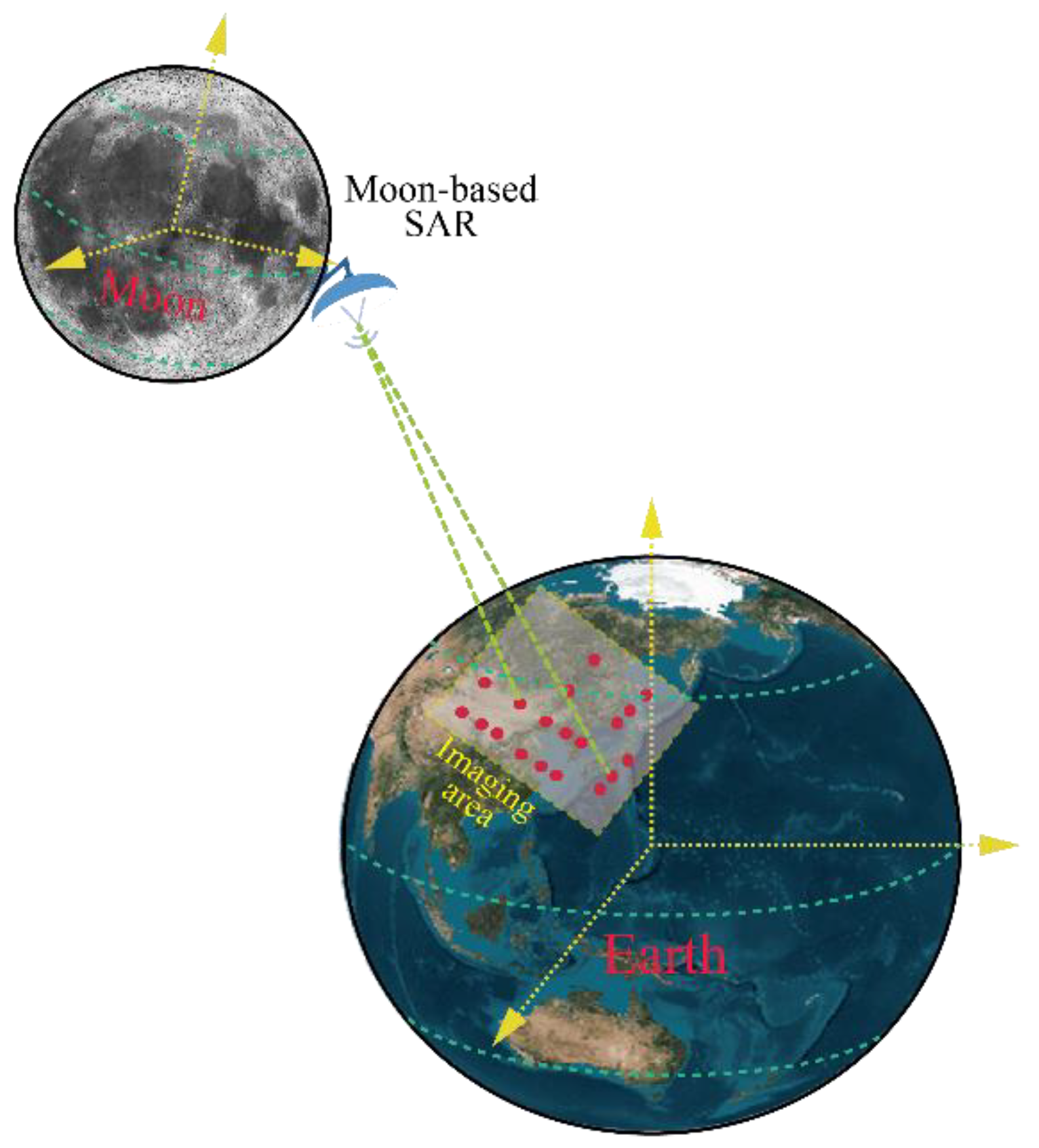
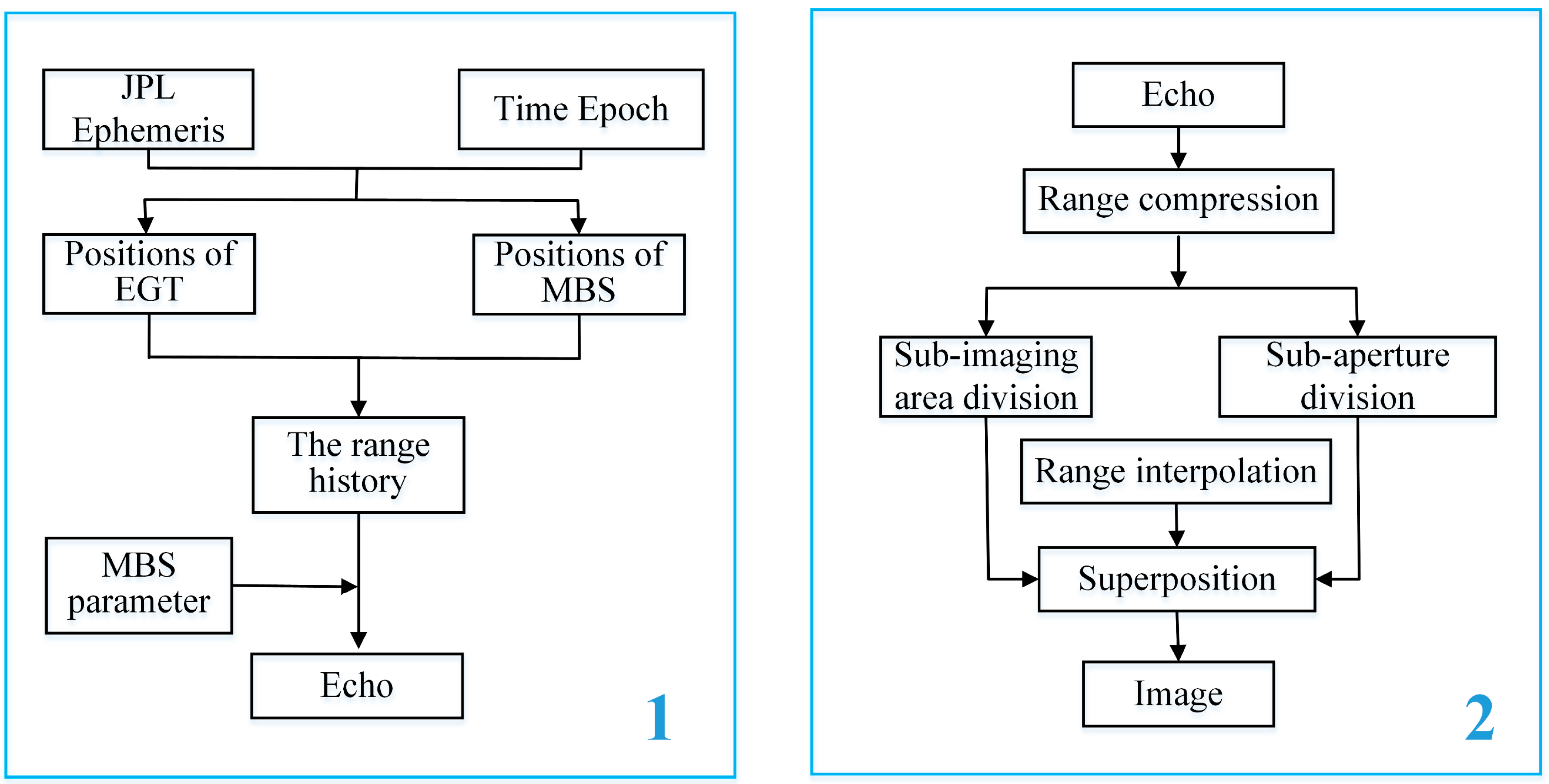
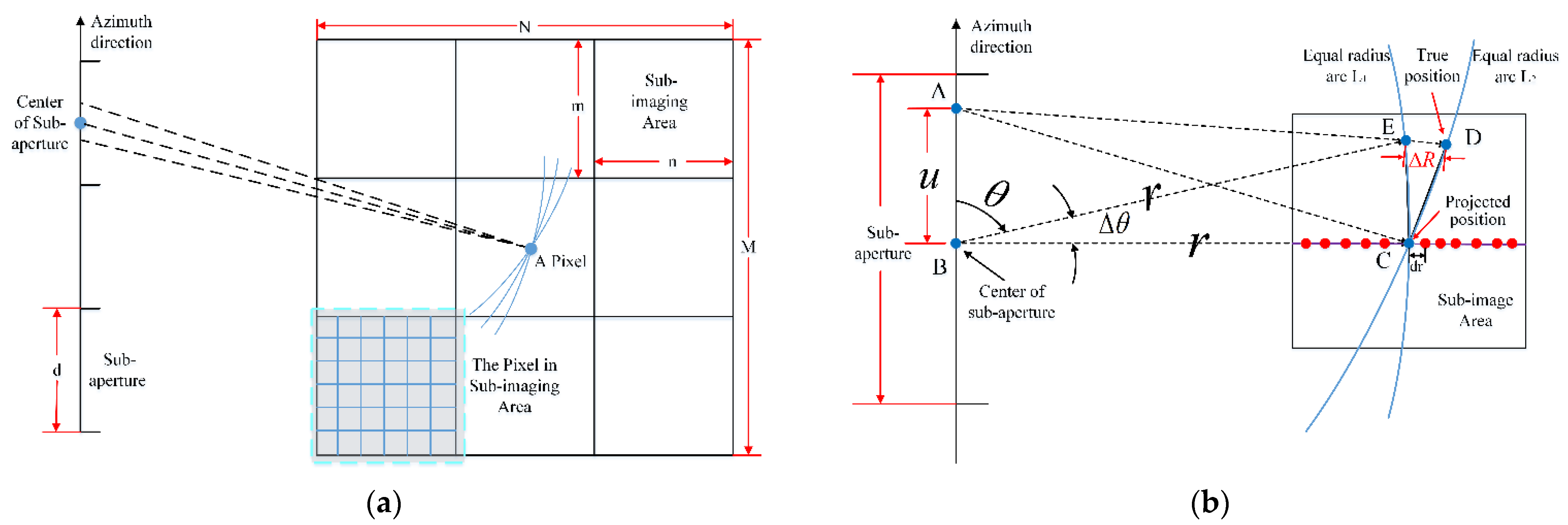
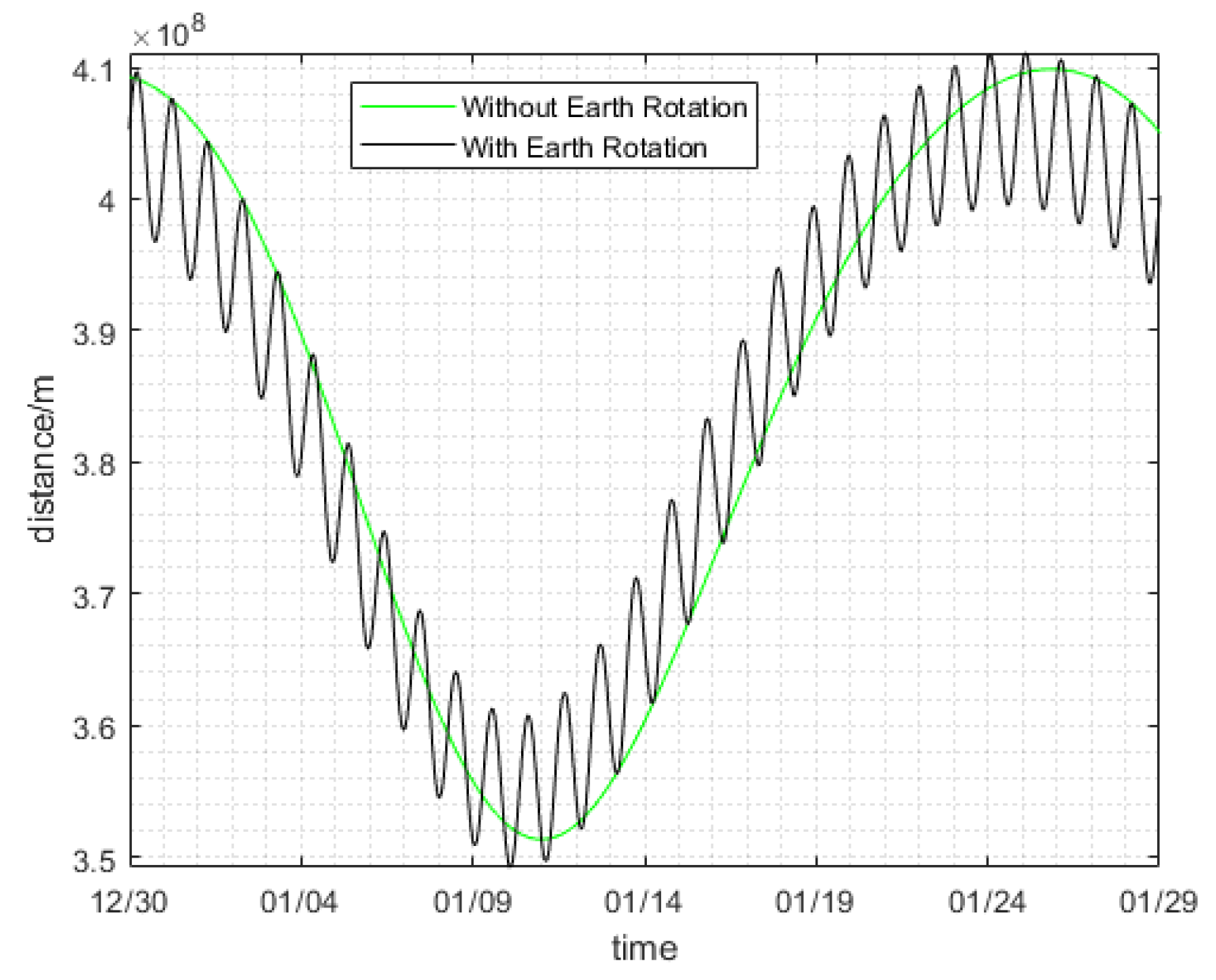
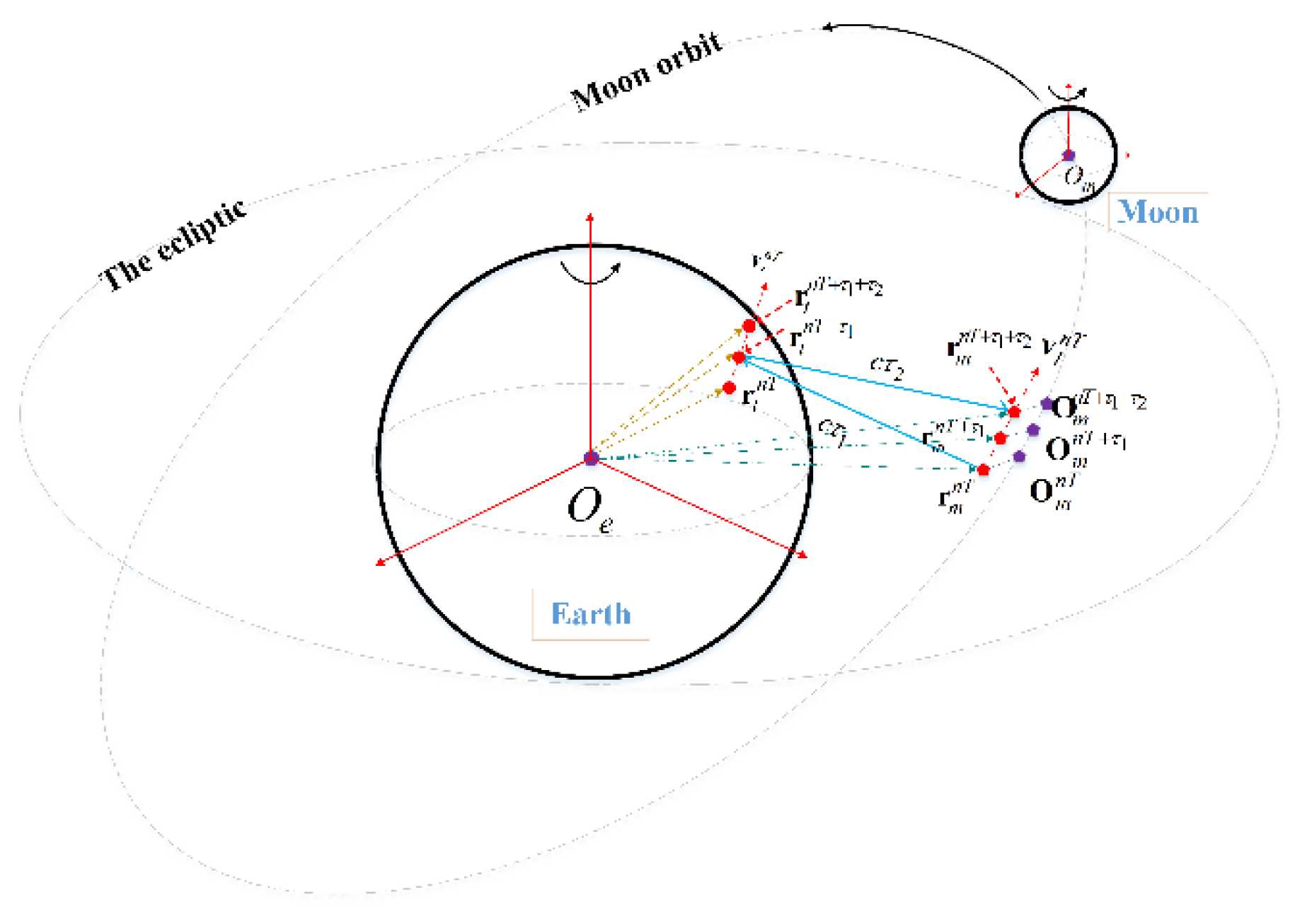

| Apogee | Perigee | Ascending Node | Descending Node | |
|---|---|---|---|---|
| MBS’s sub-point (MBS locates 30° W, 30° S) | 20.3974° S, 98.8077° W | 21.5687° N, 125.1552° W | 0.0741° S, 86.9358° W | 0.1052° S, 59.3042° W |
| EGT’s location in 0.1° look angle (MBS locates 30° W, 30° S) | 14.0429° S, 98.5044° W | 37.2064° N, 125.7875° W | 5.6218° N, 96.2608° W | 5.8745° N, 51.8339° W |
| EGT’s location in 0.3° look angle (MBS locates 30° W, 30° S) | 1.0986° S, 98.4419° W | 38.4506° N, 125.9474° W | 17.5481° N, 96.8640° W | 18.3314° N, 51.2914° W |
| MBS’s sub-point (MBS locates 0°, 0°) | 20.3126° S, 98.9532° W | 21.7340° N 125.2483° W | 0.0972° N, 86.9779° W | 0.0398° S, 59.4593° W |
| EGT’s location in 0.1° look angle (MBS locates 0°, 0°) | 14.1379° S, 98.9118° W | 27.3699° N, 125.2809° W | 5.7921° N, 95.8230° W | 5.9248° N, 51.4363° W |
| EGT’s location in 0.3° look angle (MBS locates 0°, 0°) | 1.2075° S, 98.8328° W | 38.6006° N, 125.3594° W | 17.7037° N, 96.4098° W | 18.3666° N, 50.8652° W |
| MBS’s sub-point (MBS locates 30° E, 30° N) | 20.2221° S, 99.0994° W | 21.8957° N, 125.3419° W | 0.2606° N, 87.0416° W | 0.0454° N, 59.6056° W |
| EGT’s location in 0.1° look angle (MBS locates 30° E, 30° N) | 14.2114° S, 99.3207° W | 27.5414° N, 124.7727° W | 5.9705° N, 95.3266° W | 6.0110° N, 51.1512° W |
| EGT’s location in 0.3° look angle (MBS locates 30° E, 30° N) | 1.2649° S, 99.2249° W | 38.7875° N, 124.7680° W | 17.8967° N, 95.8939° W | 18.4669° N, 50.5550° W |
| Location of MBS | Look Angle | Difference at Apogee in 80 s | Difference at Perigee in 80 s | Difference at Apogee in 150 s | Difference at Perigee in 150 s |
|---|---|---|---|---|---|
| (30° W, 30° S) | 0.1° | 8.3481 | 6.9749 | 10.7724 | 8.8154 |
| (0°, 0°) | 0.1° | 3.1571 | 2.5085 | 5.4801 | 4.3417 |
| (30° E, 30° N) | 0.1° | 8.4490 | 6.8264 | 10.6760 | 8.6574 |
| (30° W, 30° S) | 0.3° | 8.5374 | 6.6981 | 10.8542 | 8.3221 |
| (0°, 0°) | 0.3° | 3.3299 | 2.2306 | 5.6345 | 3.8477 |
| (30° E, 30° N) | 0.3° | 8.4556 | 6.5315 | 10.8542 | 8.1447 |
| Location of MBS | Look Angle | Difference at Ascending Node in 80 s | Difference at Descending Node in 80 s | Difference at Ascending Node in 150 s | Difference at Descending Node in 150 s |
|---|---|---|---|---|---|
| (30° W, 30° S) | 0.1° | 24.0298 | 22.1642 | 40.6371 | 42.2243 |
| (0°, 0°) | 0.1° | 19.6996 | 16.5473 | 44.3090 | 47.1823 |
| (30° E, 30° N) | 0.1° | 14.2782 | 15.4220 | 49.0154 | 52.7617 |
| (30° W, 30° S) | 0.3° | 23.6288 | 21.1031 | 39.5041 | 39.4661 |
| (0°, 0°) | 0.3° | 19.1191 | 16.0099 | 42.9002 | 46.0779 |
| (30° E, 30° N) | 0.3° | 13.8890 | 14.4862 | 48.2349 | 49.3998 |
| Apogee | Perigee | Ascending Node | Descending Node | |
|---|---|---|---|---|
| Fitting speed | 2.4093 × 103 m/s (2.4093 × 103 m/s) | 2.1404 × 103 m/s (2.1404 × 103 m/s) | 2.4133 × 103 m/s (2.4133 × 103 m/s) | 2.4680 × 103 m/s (2.4680 × 103 m/s) |
| Fitting smallest slant range | 3.9849 × 108 m (3.9849 × 108 m) | 3.4905 × 108 m (3.4905 × 108 m) | 3.6872 × 108 m (3.6872 × 108 m) | 3.8429 × 108 m (3.8429 × 108 m) |
| MESR (second order) | 3.8981 × 10−5 m (2.2900 × 10−4 m) | 4.1425 × 10−5 m (2.2197 × 10−4 m) | 0.0015 m (0.0057 m) | 0.0013 m (0.0052 m) |
| MESR (third order) | 1.6570 × 10−5 m (4.7207 × 10−5 m) | 1.5199 × 10−5 m (4.3035 × 10−5 m) | 7.2718 × 10−4 m (7.6067 × 10−4 m) | 6.5845 × 10−4 m (6.8873 × 10−4 m) |
| MESR (fourth order) | 1.4007 × 10−5 m (2.5570 × 10−5 m) | 1.4067 × 10−5 m (2.3305 × 10−5 m) | 7.2616 × 10−4 m (7.3516 × 10−4 m) | 6.5655 × 10−4 m (6.6817 × 10−4 m) |
| Apogee | Perigee | Ascending Node | Descending Node | |
|---|---|---|---|---|
| Fitting speed | 2.4462 × 103 m/s (2.4461 × 103 m/s) | 2.0101 × 103 m/s (2.0101 × 103 m/s) | 2.3599 × 103 m/s (2.3599 × 103 m/s) | 2.4091 × 103 m/s (2.4091 × 103 m/s) |
| Fitting smallest slant range | 3.9881 × 108 m (3.9881 × 108 m) | 3.4930 × 108 m (3.4930 × 108 m) | 3.6900 × 108 m (3.6900 × 108 m) | 3.8459 × 108 m (3.8459 × 108 m) |
| MESR (second order) | 2.9206 × 10−5 m (1.8942 × 10−4 m) | 4.6849 × 10−5 m (2.2930 × 10−4 m) | 0.0015 (0.0058 m) | 0.0013 (0.0053) |
| MESR (third order) | 2.2769 × 10−5 m (5.4061 × 10−5) | 1.8835 × 10−5 m (4.2498 × 10−5 m) | 7.4297 × 10−4 m (7.7474 × 10−4 m) | 6.7282 × 10−4 m (7.0661 × 10−4 m) |
| MESR (fourth order) | 2.0802 × 10−5 m (3.2067 × 10−5 m) | 1.7405 × 10−5 m (2.5272 × 10−5 m) | 7.3999 × 10−4 m (7.5090 × 10−4 m) | 6.7180 × 10−4 m (6.8456 × 10−4 m) |
| Apogee | Perigee | Ascending Node | Descending Node | |
|---|---|---|---|---|
| MBS’s speed (m/s) | 971.7 | 1102.2 | 1039.8 | 997.2 |
| East’s speed (m/s) | −420.865 | −412.103 | −448.733 | −450.012 |
| North’s speed (m/s) | 2.704 | −2.184 | −6.803 | 6.265 |
| Up’s speed (m/s) | −0.017 | −0.002 | 1.168 | −1.027 |
| Distance of moon-earth centroid (km) | 4.0656 × 108 m | 3.5713 × 108 m | 3.7670 × 108 m | 3.9715 × 108 m |
| Parameter | Value |
|---|---|
| Carrier frequency | 9 GHz |
| Pulse width | 100 us |
| Range bandwidth | 3 MHz |
| Azimuth oversampling | 1.2 |
| Range oversampling | 1.2 |
| Azimuth width angle | 0.014° |
| Range width angle | 0.028° |
| Look angle | 0.3° |
Publisher’s Note: MDPI stays neutral with regard to jurisdictional claims in published maps and institutional affiliations. |
© 2022 by the authors. Licensee MDPI, Basel, Switzerland. This article is an open access article distributed under the terms and conditions of the Creative Commons Attribution (CC BY) license (https://creativecommons.org/licenses/by/4.0/).
Share and Cite
Chen, G.; Guo, H.; Liang, D.; Han, C.; Ding, Y.; Jiang, H.; Zhang, K. Theoretical Feasibility Analysis of Fast Back-Projection Algorithm for Moon-Based SAR in Time Domain. Appl. Sci. 2022, 12, 3850. https://doi.org/10.3390/app12083850
Chen G, Guo H, Liang D, Han C, Ding Y, Jiang H, Zhang K. Theoretical Feasibility Analysis of Fast Back-Projection Algorithm for Moon-Based SAR in Time Domain. Applied Sciences. 2022; 12(8):3850. https://doi.org/10.3390/app12083850
Chicago/Turabian StyleChen, Guoqiang, Huadong Guo, Da Liang, Chunming Han, Yixing Ding, Huiping Jiang, and Ke Zhang. 2022. "Theoretical Feasibility Analysis of Fast Back-Projection Algorithm for Moon-Based SAR in Time Domain" Applied Sciences 12, no. 8: 3850. https://doi.org/10.3390/app12083850









